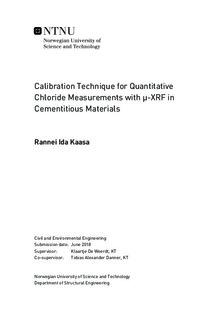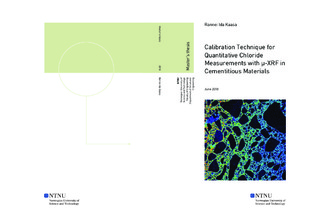| dc.description.abstract | Corrosion due to ingress of chlorides is one of the major deterioration mechanisms of reinforced concrete structures exposed to seawater or de-icing salts. The chlorides are transported through the porous cement paste in the concrete. Corrosion will initiate when the chloride content in vicinity of the reinforcement reaches a critical limit. To determine the chloride content, a concrete core is profile ground to obtain concrete powder at different depth intervals. Subsequently, a wet chemical analysis e.g. potentiometric titration of the powder is performed. Wet chemical analysis is a precise, but time-consuming and labour-intensive method.
A less labour-intensive method recently introduced is micro X-Ray fluorescence (µ-XRF). With µ-XRF, elemental mappings e.g. chloride maps of split or sawn concrete surfaces can be determined. However, the signal of µ-XRF (counts per second=CPS) is not in a unit describing a concentration e.g. percentage of weight. As the chlorides are mainly present in the cement paste, a calibration curve relating the CPS of chlorine to a weight percentage of cement paste has to be established if µ-XRF is to be applied for determining the chloride content in cementitious materials.
In this study, cement paste samples with different water-to-cement ratio and known chloride contents were prepared. To study the effect of storage, paste samples were stored in isopropanol and on a desk. All samples were analysed by µ-XRF and a calibration curve was plotted based on the measured CPS of chlorine and the chloride content of the samples.
A technique for measuring the chloride content of mortar and concrete samples with µ-XRF was established. Based elemental maps from the µ-XRF and by use of software, the cement paste and aggregates were differentiated. The area percentage of aggregates and the CPS for the cement paste were obtained from the differentiation. The accuracy of the technique was then evaluated by comparing the chloride content determined by µ-XRF with the chloride content determined potentiometric titration. As the chloride content from titration was given by weight of concrete, a calculation model relating the CPS directly to the chloride content by weight of concrete was established. The basis of the calculation model was the calibration curve and the area percentage of aggregates.
The measurements resulted in a linear relation between the CPS and the chloride content of paste samples. In the range of 0.0 to 1.2% chlorides by weight of paste, the relation was found to be independent of the water-to-cement ratio. The relation can be used as a calibration curve to determine chloride contents of cement paste by µ-XRF. Furthermore, the detection limit of µ-XRF was found be lower than that of titration.
The results revealed that the parameters used for performing elemental mappings have an effect on the differentiation of the cement paste and aggregates. Which will consequently affect the determination of chloride content in the paste. For low chloride contents, the technique gave comparable results with the chloride content from titration of the mortar samples. However, for high chloride contents the results deviated. Except for one sample, comparable results with the titration were also obtained for the concrete samples, indicating that the technique can be used to determine chloride contents in cementitious materials. The technique had especially good accuracy for chloride contents near the critical chloride limit. However, the storage of the samples was found to have an effect of the measured CPS. These effects should be studied further to determine the proper storage of cementitious samples prior to µ-XRF measurements. | |

